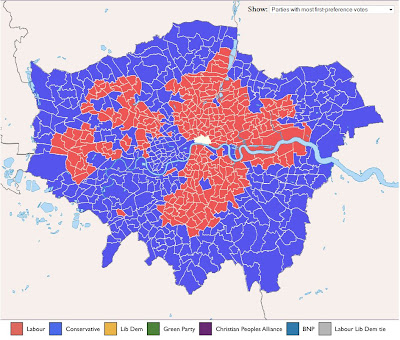This Thursday you’ll have the chance to vote for the next Mayor of London. I expect most of you know this.
You will also have the chance to vote for the next London Assembly member representing the constituency of Barnet and Camden. I expect quite a lot of you didn’t know that.
Lets get the mayor out of the way first and deal with the Assembly election in the next post. This is largely a rehash of the last mayoral election, with Boris Johnson (Con), Ken Livingstone (Lab), and Brian Paddick (LD) all standing again. It’s the first time Jenny Jones (Green) has run for mayor, but she was deputy mayor under Ken Livingstone in 2003/4.
 |
| Boris, Ken, Brian and Jenny |
Why should the 2012 result be any different from 2008? Well, Boris has had four years in office, so to some extent this is a referendum on how well he’s done. Ken meanwhile beat Oona King to the Labour nomination, but having been Mayor for two terms already does the electorate feel he’s had his time to shine? Paddick – who only polled 9.6% first preference votes in 2008 – can’t help but be tainted by the Lib Dem’s fall in popularity since the coalition agreement. Jenny Jones, who has been a London Assembly member since 2000, could be a surprise package this time around, but few pundits are predicting anything other than a straight two-way fight between Boris and Ken. There are other candidates: the inevitable UKIP, BNP and independents, but none have even a distant shot at taking City Hall.
The campaign has been pretty negative so far – a lot of energy is being expended on why you shouldn’t vote for the other candidate – whether it’s because Ken channeled money into a private company to (legally) reduce his tax bill , or whether it’s because Boris supports flights of fancy such as cable cars across the Thames, while being accused of failing to tackle knife crime.
All the negative campaigning makes it hard to get excited about the election at all frankly. What are the key issues in West Hampstead, and what do the main candidates have to say about them? I met Brian Paddick a few weeks ago to get his perspective, which is very heavily skewed to the issue of policing and crime (he’s a former Asst. Commissioner of the Met in case you’ve never heard him speak). In advance, I asked my twitter followers for their main concerns: crime did figure, as did housing, and to some extent transport – and these are really the key concerns across the city I think. The mayor doesn’t have a lot of say over the broader economy or the NHS for example.
Lets take a look at the key policies on these areas.
Policing
This has been one of the biggest bones of contention between Boris and Ken – has Boris cut police numbers or hasn’t he? According to The Guardian,
“Johnson’s campaign is correct in claiming that police officer numbers have risen over his term, albeit only by 2.4% if you take the baseline to be the March 2008, closest to when he was elected in May. But Labour is right that since 2009, the last year that Livingstone budgeted for, numbers have fallen overall by 1.17%.”
Read the full analysis to decide for yourself whether there’s a left-leaning Guardian bias there. I don’t see it personally.
Boris: “[I will] deliver a massive boost to Safer Neighbourhood Teams, with an additional 2,000 police, including adding up to three police officers, to every team. Each team will also get three Special Constables to further boost police presence in our neighbourhoods.” Read more at http://www.backboris2012.com/crime.
Ken: “If I am elected, I will reverse [Boris’s] cuts. And I will reinstate sergeants to all 600 Safer Neighbourhood Teams, more of which will be beefed up to a minimum of nine officers.” He makes policing one of his “top two” priorities alongside cutting fares. Read more at http://www.kenlivingstone.com/police.
Brian: “We will guarantee 33,500 police in the Met by protecting local neighbourhood teams from the current Mayor’s cuts and putting more police on the streets in communities most at risk from gun and knife crime.” He also advocates the so-called “Paddick patrols”, consisting of “community groups such as residents and tenants associations patrolling in groups to prevent crime and be the ‘eyes and ears’ of the police.” Read more in Paddick’s full manifesto at http://www.brianpaddick.com/london_2012_manifesto.pdf.
Jenny: “We will put more officers on the beat focused on important areas such as road safety, not unnecessary surveillance. We will rebuild trust in the police, especially amongst the young.” (crime is the fifth on her list of five-point plan for London). Read more at http://www.jennyforlondon.org/fresh-ideas/.
On crime, perhaps only Paddick stands out as having distinctive ideas. He told me that he thinks there are too many specialist officers now and numbers need to be rebalanced in favour of normal front line police. I suggested he was a single issue politician, which he rejected, claiming it was easy to stereotype candidates and he had gone to Oxford and had an MBA and a commercial career before the Met. Nevertheless, when I asked him why I should vote for him, his answer revolved entirely around his crimefighting credentials and crime and police leads his manifesto.
Housing
The new mayor will have substantial new powers over housing in the capital. It may not be an issue of immediate concern for many Londoners, but for those for whom it’s critical, or for people who understand its long-term relevance for the well-being of the city, the candidates’ housing policies should be of major import. For an overview of the big three candidates’ policies, I’d suggest watching this BBC London interview, but what can we learn from the manifestos?
Boris: It’s notable thought that housing doesn’t crop up at all in Boris’s manifesto. In fact it appears he doesn’t have any new policies at all, which given the new powers and budget seems extremely strange.
Ken: “My focus will be first, to drive down costs and drive up standards across all housing tenures including those who rent from private landlords, those who rent from social landlords and those who own, or are buying, their own homes. As a priority, I will help reduce the price and improve standards of private rented accommodation by establishing a not-for-profit lettings agency that saves tenants and landlords money by avoiding rip-off estate agents’ fees, and creating a Tenants’ Charter that sets minimum standards for rented accommodation. No-one should have to spend more than a third of their earnings on rent and we will develop the case for a London Living Rent.
“Second, I will address the long-term housing crisis we simply have to build more new homes and they need to be affordable to ordinary Londoners to rent or buy. That means making maximum use of land controlled by the Mayor for housing development, and enforcing tough planning regulations so that private developments reflect the needs of all Londoners.” Read more in Ken’s full manifesto.
Brian: “We plan to build 360,000 homes over a decade and will create a new ‘living rent’ standard, so that Londoners’ rent costs should aspire to be no more than one-third of their take home pay. We will work with all London boroughs to restart council home-building and aim for half of all new homes built in London being in the Social and Intermediate sectors by supporting boroughs with the best legal advice to negotiate tough agreements with developers. A London Housing Company would act as a vehicle to assemble public land and match it with private investment, and offer smaller housing associations the ability to raise loan capital through a London Housing Bond. We will create an extra 40,000 homes in the spaces above shops and bring 50,000 currently empty homes back into use.” Read more in Brian’s full manifesto.
Jenny: “Our 10-point plan manifesto pledges to build at least 15,000 new homes a year, and refurbish over a million to help reduce energy bills. We have also committed to reduce rents and provide greater security for private tenants through five-year contracts and the establishment of an ethical lettings agency. We also pledge to help families by making sure 40% of new homes are family-sized, help cooperatives build more homes by establishing a London Mutual Housing Company and helping to set-up Community Land Trusts, end rough sleeping and ensure no one has to spend more than one night on the streets by centralising money for homelessness services in London, campaign against government attacks on housing, campaign for reform, including land value taxation and a ban on foreign investors.” Read more in Jenny’s housing manifesto.
I asked Brian Paddick about planning, as he had commented in passing on the 187-199 West End Lane development. He said that he would ensure that “development density doesn’t adversely affect an area, and he would seek to preserve the nature of local area.” I’m not sure what that means in practice really, but he added that “one of the most important aspects of West Hampstead is its character.”
Transport
For many Londoners this is a huge issue, and one of the few areas where the Mayor has real power as TfL falls squarely under the Mayor’s remit. There are clear distinctions here between the four candidates.Fare structures are always a headline issue. Boris pleges only to “ensure transparency and honesty over fares policy”. Ken simply says he’ll cut fares by October or resign. Under Brian fares will be restructured (and the one-hour bus ticket is surely a good idea that all the candidates should introduce bringing London in line with most major cities), and under Jenny they are guaranteed not to exceed inflation.
Boris: (quoted from his manifesto but stripped of rhetoric) “I will cut delays on the Tube by a further 30% by harnessing new technology and introducing new working practices to ensure problems are fixed urgently. I will reverse the last Labour Government’s decision to stop Londoners getting their Freedom Pass at 60. I will pave the way to the first driverless (although not unmanned) trains within a decade by accelerating a programme to introduce automation on the Tube. I will also ensure that TfL never orders a new train for London Underground with an old fashioned driver cab. I will argue our case for a minimum turnout rule which will prevent union leaders calling strikes with a minority of supporters. I will support the extension of the Docklands Light Railway to Bromley.”
“I will launch a Congestion Busting Plan, including funding for immediate improvements to London’s worst congestion hotspots. I will use the income from Lane Rental, which will tackle road works, to ease the congestion they cause. And I will enact the first comprehensive review of the road network for a generation, with detailed plans to end London’s worst congestion points – seeking improvements for drivers, bus passengers and cyclists. I will also expand our hugely successful Cycle Hire scheme to many new parts of Greater London.” Read more in Boris’s transport manifesto.
Ken: I will cut fares by 7% this year and freeze them throughout 2013. Oyster single bus fares will be reduced from £1.35 to £1.20. From 2014 fares will not rise above inflation.” Here’s the maths that shows how he’ll pay for it. He argues that over his 4-year term, the average Londoner would be £1,000 better off under his fare scheme compared with what would happen if Boris was in charge.
He continues, “I will provide bus services that reflect passengers’ demands for easier travel in the suburbs; offer new ways for bus users to report problems by phone, text and smartphone, and display them online along with TfL’s responses; deal with the roadworks and accidents that cause the majority of bus delays; work with borough councils to identify the main congestion points and bring forward bus priority measures to speed up bus passengers’ journeys; bring forward plans to make all bus stops accessible – there is no point having ramps on all buses if they can’t be used at some bus-stops; improve training for bus drivers to provide passengers with a more comfortable journey – particularly ensuring all older passengers are seated before the bus moves off; and save tens of millions of pounds by cancelling the Tory Mayor’s ‘new bus for London’.”
He also pledges to “work tirelessly with transport bosses to ensure that passengers come first and the Tube upgrade programme is carried out with the minimum of disruption to people’s busy lives; bear down on Monday morning over-runs; and deliver Tube improvements more quickly by ensuring that TfL spends the capital funds allocated to it. I will also ensure that more of the Tube is made accessible to everyone, from people struggling with luggage, to older and disabled Londoners.” Finally, Ken would introduce a one-day 2-6 ZoneSaver card.
On the roads, “I will cut congestion through SMART parking [using apps to find parking spaces]; focus on roadworks; and enable more Londoners to have access to car clubs.” He also has details on his cycling strategy, with a stated focus on road safety – a hot topic right now. For more, read Ken’s full manifesto.
Brian: On fares, “Our package of fare reductions will concentrate help where it is most needed: Early Bird discounts for Tube, TfL rail and DLR travellers using the network before 7.30am; a One Hour bus ticket allowing people to hop-on and hop-off buses as you can on the Tube and rail – paying only one single fare; a part-timers’ Travelcard using Oyster technology, so people regularly travelling three days a week can get
the sort of discounts provided by the weekly travelcards; One Day outer London Travelcard. We will review all the fare zones across London so passengers are not disadvantaged. We will end the scandal of Oyster overcharging, and where it does occur, make it far quicker and easier to get a refund.
“We will speed up work to increase capacity through ‘block closures’ [on tube lines – i.e., closing sections of lines for a couple of weeks, rather than doing weekend work] and bring forward schemes for ultra light rail, tram and additional buses in badly served areas and on overcrowded routes. We will create a London Transport Bond to raise additional investment funds, open to ordinary Londoners, so they get a good return on their savings as well.
“We will give holders of Oystercards a real say in how their network is run just as big companies have to answer to their shareholders, by using existing contact details to consult through email and phone-in votes. We will make a ‘Big Switch’ so all London’s buses and taxis, and most commercial vans run on electricity by 2020, to cut running costs and clear up polluted air, with a clean air zone for central London such as cities like Berlin enjoy. We will pedestrianise parts of central London – from Trafalgar Square to Oxford Street – and run a ‘summer streets’ scheme, like New York.” Read more in Brian’s full manifesto.
Boris, Ken and Brian all want to take control of suburban rail services.
Jenny: I will guarantee fare rises do not exceed inflation and provide greater investment to improve services and reduce overcrowding, raise money for public transport, reduce congestion and improve air quality through a ‘pay-as-you-go driving’ scheme to replace the arbitrary congestion charge. I will clean up London’s buses, converting the entire fleet to low emission hybrid, hydrogen or electric models by 2016. I will introduce 20mph speed limits on all roads where people live, work and shop, and create more pedestrianised areas to create safer and more pleasant streets for those on foot or bike. I will help more Londoners cycle by providing clear, dedicated, safe spaces for cyclists on main roads and dramatically increase training for children.
Cycling is a major – indeed separate – policy for Jenny. You can read much more about it at http://www.jennyforlondon.org/fresh-ideas/londoncycling/. Ken, Brian and Jenny all refer to the cycling culture in The Netherlands as a blueprint for London.
Conclusions
Who to vote for? Have a read of the manifestos, and see what you think. The candidates have plenty to say about other topics, I’ve just highlighted three of the biggest topics. Clearly, the mayor is also a figurehead role, so someone who you feel represents you and this great city may be more important than party affiliation. It feels like a sadly uninspiring line-up this time around. As I waited to meet Brian Paddick in a Primrose Hill café, none other than playwright Alan Bennett walked in. It’s a shame someone of his stature isn’t standing.









